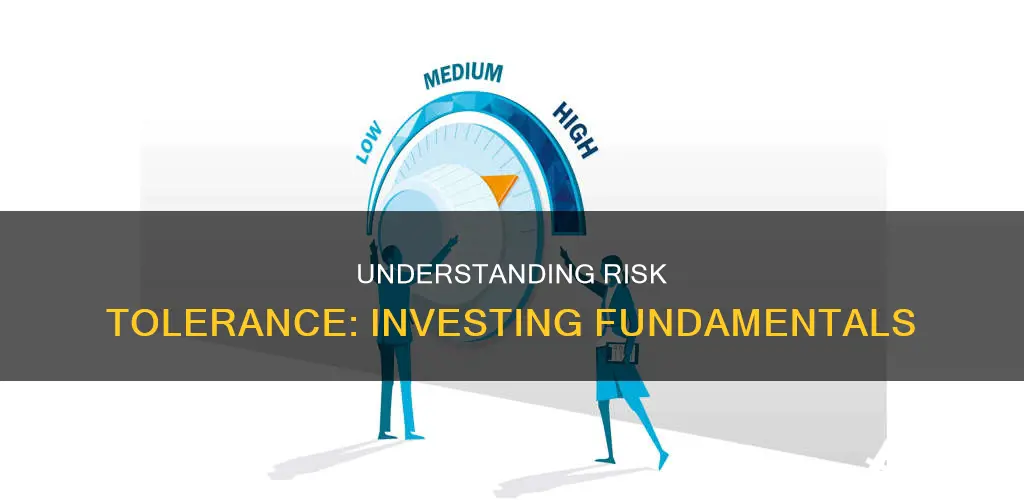
Risk tolerance is a crucial aspect of investing, referring to an investor's ability and willingness to endure potential losses in pursuit of greater returns. It is defined by the U.S. Securities and Exchange Commission (SEC) as an investor's ability and willingness to lose some or all of an investment in exchange for greater potential returns. Risk tolerance varies from person to person and is influenced by factors such as financial situation, goals, time horizon, and comfort with uncertainty. Understanding one's risk tolerance is essential for making informed investment decisions and building a portfolio that aligns with their tolerance for risk and financial objectives.
| Characteristics | Values |
|---|---|
| Definition | "An investor's ability and willingness to lose some or all of an investment in exchange for greater potential returns." |
| Determining factors | Investment goals, time horizon, comfort with short-term loss, savings, tracking of investments, age, income, future earning capacity, other assets, portfolio size, comfort level |
| Investor types | Aggressive, moderate, conservative |
What You'll Learn

Risk tolerance vs. risk capacity
Risk tolerance and risk capacity are two important factors that influence investment decisions. While both are related to risk, they represent different concepts and can impact an investor's strategy in distinct ways.
Risk Tolerance
Risk tolerance refers to an investor's willingness to take on risk. It is a subjective and personal decision that can be influenced by personality traits, age, income, family situation, and net worth. Some individuals may be more comfortable with taking risks, while others may be more risk-averse. Risk tolerance can also fluctuate over time as an investor's circumstances change. For example, an investor may become more risk-averse as they approach retirement age.
Risk Capacity
On the other hand, risk capacity is a more objective and fact-based measurement. It refers to an investor's financial ability to take on risk. This includes factors such as their current assets and liabilities, projected future profits and losses, and historical data related to their investments. Risk capacity can change over time as an investor's financial situation evolves. For example, if an investor inherits a large sum of money, their risk capacity may increase.
The Relationship Between Risk Tolerance and Risk Capacity
While risk tolerance and risk capacity are independent of each other, they can influence each other and impact investment decisions. It is important for investors to consider both factors when determining their investment strategy. For example, an investor with a high risk tolerance but low risk capacity may need to adjust their strategy to ensure they do not take on more risk than they can financially handle. Similarly, an investor with a low risk tolerance but high risk capacity may want to ensure they are taking advantage of their capacity to achieve their investment goals.
Applying Risk Tolerance and Risk Capacity to Investment Decisions
When determining their investment strategy, investors should consider their risk tolerance and risk capacity in relation to their goals and time horizon. For example, if an investor is saving for retirement with a long time horizon, they may be able to take on more risk as they have time to recover from potential losses. On the other hand, if an investor is saving for a short-term goal, such as a down payment on a house, they may need to be more conservative with their investments to avoid taking on unnecessary risk.
Asset Management: Understanding Investment Strategies and Benefits
You may want to see also

Investor comfort level
An investor's comfort level with risk is a major factor in determining their investment strategy. Those with a higher risk tolerance tend to invest in stocks, equity funds, and exchange-traded funds (ETFs), while those with a lower risk tolerance tend to purchase bonds, bond funds, and income funds.
Aggressive investors, who are willing to risk losing money for the chance of better results, are often wealthy, experienced, and have a broad portfolio. They are comfortable with large upward and downward movements in their portfolio and do not panic sell during market crises. Moderate investors, who want to grow their money without taking on too much risk, balance their investments between risky and safe asset classes. Conservative investors, who take the least risk, avoid risky investments altogether and opt for the safest options, prioritizing capital preservation over potential gains.
It is important to note that an investor's comfort level with risk can change over time as their financial situation, goals, and time horizons shift. Therefore, it is essential to regularly review one's risk tolerance and adjust investment strategies accordingly.
Troy, MI: The Smart Investment Hub
You may want to see also

Time horizon
When determining your risk tolerance, it's important to consider your time horizon, or when you plan to withdraw the money you've invested. Your time horizon depends on what you're saving for, when you expect to begin withdrawing the money, and how long you need the money to last.
Goals like saving for retirement have longer time horizons than saving for a vacation or a down payment on a house. In general, the longer your time horizon, the more risk you can assume because you have more time to recover from a loss. As you near your goal, you may want to reduce your risk and focus more on preserving what you have rather than risking major losses at the worst possible time.
For example, if an individual needs a certain sum of money at the end of 15 years, they can take on more risk than someone who needs the same amount by the end of five years. This is because the market has shown an upward trend over the years, although there are constant lows in the short term.
If your investments lose value, a longer time horizon gives you time for them to recover. While downturns do occur, and past performance is no guarantee of future results, the stock market has historically returned about 8.5% per year on average, accounting for inflation.
A shorter time horizon means your investments have less time to recover from a potential downturn. If your goal is to earn a big return in a short time, you'll need to be comfortable with risk. If the market falls suddenly within your time horizon, you may not meet your goal on time.
Your time horizon can also influence your approach to risk. If you have a longer time horizon, you may have greater returns by carefully investing in higher-risk assets, such as stocks. Conversely, lower-risk cash investments may be more appropriate for shorter-term financial goals.
Portfolio Investment Scheme: India's Investment Gateway
You may want to see also

Risk and reward
An investor's risk tolerance can be classified into three main categories: aggressive, moderate, and conservative. Aggressive investors have a high-risk tolerance and are willing to risk losing money in pursuit of potentially better returns. They tend to be market-savvy and comfortable with volatile investments such as stocks and equity funds. On the other hand, conservative investors have a low-risk tolerance and seek investments with guaranteed returns. They prioritise capital preservation over high returns and often invest in low-risk options like bonds, money markets, or certificates of deposit. Moderate investors fall between these two extremes, balancing their investments between risky and safe asset classes.
The relationship between risk and reward is simple: the higher the risk, the greater the potential for reward or loss. While taking on more risk can lead to larger payoffs, it also puts an investor's tolerance to the test. For example, an aggressive portfolio may offer the potential for substantial gains, but it is also more volatile and susceptible to significant declines during market downturns. Conversely, a conservative portfolio may provide steadier returns but typically achieves lower annualised returns over time.
Determining your personal risk tolerance is a fundamental step in investing. It helps you make asset allocation choices that align with your financial goals and comfort level. For instance, if you are saving for retirement and have a long time horizon, you may be able to take on more risk as you have time to recover from potential downturns. In contrast, if you are saving for a short-term goal like a house down payment, you may opt for more conservative investments to reduce the risk of losses close to your goal.
It is essential to remember that risk tolerance is not static and can change over time as your financial circumstances, goals, and time horizons evolve. Therefore, regularly reviewing your risk tolerance and adjusting your investment strategy accordingly is vital to ensuring that your investments remain aligned with your comfort level and financial objectives.
Investment Bankers: How Much Do They Really Make?
You may want to see also

Types of risk tolerance
Risk tolerance is an important factor in investing, but it can be tricky to gauge. It is influenced by factors such as an individual's financial situation, goals, and timeline.
There are two main types of risk tolerance: risk tolerance and risk capacity. While similar in name, they are generally independent of each other.
Risk Tolerance
Risk tolerance refers to an investor's comfort level with uncertainty and potential losses. It is a subjective measure of how much risk an individual is willing to take. This can be influenced by factors such as behavioural tendencies and past experiences with investing. Risk tolerance might not change over an individual's lifetime.
Risk Capacity
Risk capacity, on the other hand, refers to how much investment risk an individual is able to take on. This is determined by their financial situation, including any income needs or financial obligations. Risk capacity is more flexible and can change over time as personal and financial goals evolve. For example, an individual with a mortgage, children, or elderly parents to support may have a lower risk capacity than someone who is single and has fewer financial commitments.
It is important for investors to consider both their risk tolerance and risk capacity when making investment decisions. This can help them build a portfolio that aligns with their comfort level and financial circumstances, reducing the likelihood of costly mistakes.
Equities: How Much is Enough?
You may want to see also
Frequently asked questions
Risk tolerance is the level of risk an investor is willing to take. It is the amount of market volatility and loss an investor is willing to accept.
While similar in name, risk capacity and risk tolerance are independent of each other. Risk capacity is how much investment risk an individual is able to take on, whereas risk tolerance is the willingness to take on risk. Risk capacity is more flexible and changes with financial goals and the timeline for achieving them.
Risk tolerance often determines the type and amount of investments an individual chooses. It helps investors plan their entire portfolio and influences how they invest. For example, individuals with a low-risk tolerance tend to invest more conservatively, opting for more low-risk investments.
There are several factors that influence risk tolerance, including age, investment goals, income, and financial situation. You can assess your risk tolerance by asking yourself questions such as: What are your investment goals? What is your time horizon? How comfortable are you with short-term losses? Do you have non-invested savings?







